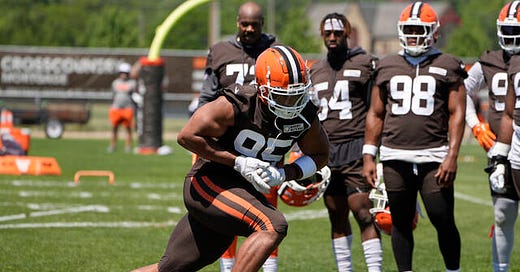Reigning NFL Defensive Player of the Year, Myles Garrett, "Tweaks" Hamstring: Browns Not Concerned
The NFLs Reactive Strength problem strikes again at minicamp. The NFL has a real problem on its hand that is only going to amplify.
Same Old, Same Old
“The Browns wrapped up their offseason program Thursday at the conclusion of the final minicamp practice.
The team did receive a scare early in the practice when edge rusher Myles Garrett ended a defensive line drill holding his left hamstring, Chris Easterling of the Akron Beacon Journal reports. The reigning defensive player of the year immediately sought out head athletic trainer Joe Sheehan and assistant athletic trainer Gordon Williams.
Garrett did not participate in the rest of practice, doing upper-body resistance band work by himself for a few minutes before talking with co-owner Dee Haslam.
Coach Kevin Stefanski expressed no concern about Garrett’s hamstring.
“He will be fine,” Stefanski said, via Easterling.”1
You Read That Right
Yep, you read that right. The Browns' head football coach expressed no concern, saying, "He will be fine." Now, we understand that Stefanski has to say that. However, as strength practitioners - not ball coaches - we know that this "tweak" indicates that Garret has abnormal connective tissue architecture in that hamstring. Simply, the bottom-up element of reactive strength is signaling that it cannot transmit the force that Garrett’s nervous system is generating in dynamic concentric to eccentric contractions scenarios - see how the connective tissue is a limiting constraint on Garrett’s CNS.
Absolute subscribers understand that this is not a good sign, as these bottom-up reactive strength injuries have been a real problem for the NFL and its players - a problem for which they currently do not have a solution. What we have to say to the head ball coach is: You should be concerned, as these injuries are not a free lunch - meaning: there are both biological and neurological consequences to these "tweaks," and those consequences are very nonlinear. For Garrett's sake, we hope that he and his team address these consequences and that he reaches Point B before the start of training camp.
The NFL’s Endless Reactive Strength Injury Examples
It’s 2024, right? Yes, it is, and the reigning NFL Defensive Player of the Year, who makes $25,000,000 per year, just tweaked his hamstring at the end of the final minicamp practice. We told you this week, using the Christian Watson case, that these reactive strength injuries were going to amplify, and the NFL, with their 2000s training paradigm, never disappoints us - like taking candy from a baby. We were gearing up to cover this reactive strength problem and use the NFL to illustrate our point, but we planned to do so at the start of the season, not at the end of minicamp.
Living in the 2000s Training Paradigm
When we look at the NFL’s reactive strength problem, what we are witnessing in real time is a positive feedback loop that is only amplifying. One component of this loop involves strength staffs being highly proficient in a 2000s neurological training paradigm. In this nonecological paradigm, the staffs excel at using training to scale up the top-down neurological component of reactive strength but not the bottom-up biological connective tissue component. That's why we see these players' neurology continually outpacing their biology, leading to bottom-up connective tissue reactive strength injuries - with Garrett being the latest example.
Louie Simmons is Responsible
The 2000s was the back end of the reign of Louie Simmons's multi-decade complete stranglehold on the Powerlifting scene. As all-time world-record-setting powerlifter Donnie Thompson says in the Westside vs. the World Documentary: "Like it or not, it happened." When that first all-time world record fell in 1985 on Matt Dimel’s 1010lbs squat, we can only imagine that it triggered something in Louie that this sport of Powerlifting was his for the taking, and man, did he. But the success in that sport will not translate to other sports, even when the athletes are absolute strength athletes. This is due to the physiological fact that physical prerequisites, that is, Point B, will be different at different levels of competition.
Through skin in the game (and soul in the game), Louie and his barbell club figured out how to sequence nervous system training methods, that is, the Max Effort Method and the Dynamic Effort Method, in a manner that scaled his absolute strength athletes, powerlifters, neurologies to output in ways we never would have imagined. Louie scaled their nervous systems to the point where over 140 all-time world records fell at a pace that we will never, ever see again. Thank you, Lou - we miss you, and we, as strength practitioners, will always owe you.
But here’s what has happened: strength coaches outside the walls of that small, exclusive club started to utilize Louie's sequence. As these strength coaches became proficient in applying what Louie taught us, they learned how to effectively train the athlete’s neurology. However, they didn’t learn how to train the other ecologies in Point B - specifically joint function and connective tissue, the biological bottom-up component of reactive strength. Absolute readers understand that neurology is only two components of Point B, absolute strength and speed strength - these coaches don’t and are now learning about those other trainable ecologies the hard way.
So here we are in 2024. We have strength coaches who do not understand how effective the training methods are and how fast the neurology will scale when training is sequenced, as Lou would say, "optimally." It's like we've given pyromaniacs matches - the neurological training methods sequenced optimally - and the kindling is the NFL athlete.
Louie was Smarter
Keep reading with a 7-day free trial
Subscribe to Absolute: The Art and Science of Human Performance to keep reading this post and get 7 days of free access to the full post archives.







